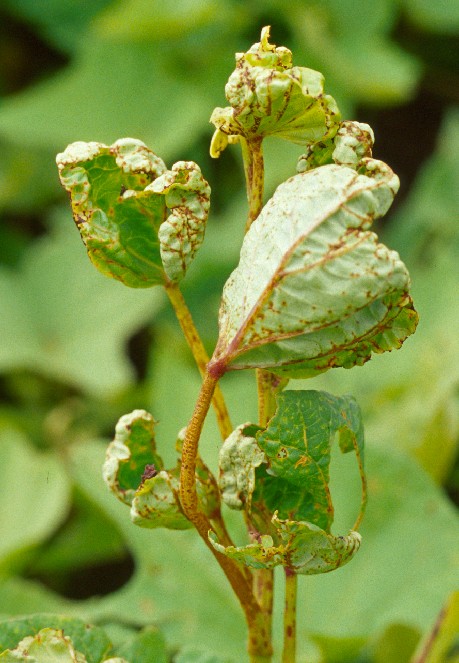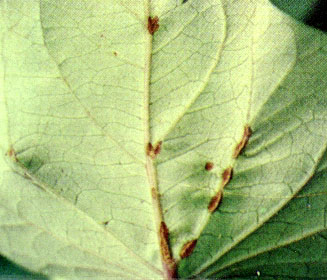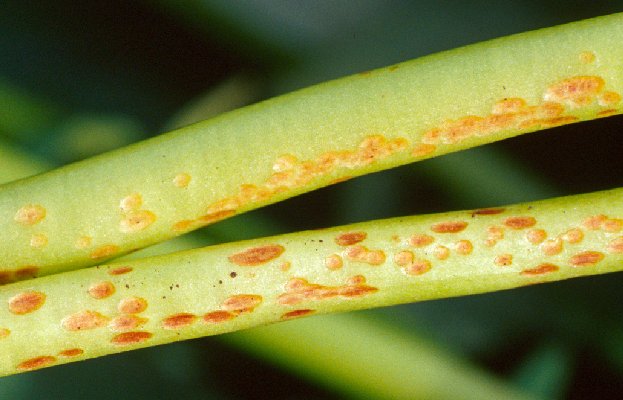|
|
Kingdom |
Fungi |
|
Phylum |
Ascomycota |
|
Order |
Dodideales |
|
Family |
Elsinoaceae |
Scab is the most severe fungal disease of sweetpotato in South East Asia and
the Pacific. In Queensland, Australia, 20% yield losses were reported for the
cultivar ‘Puerto Rico’. In the Philippines, yield losses reached 50%, and in
Papua New Guinea losses of up to 57% were noted.
When plants are affected at an early stage, the yield of marketable roots is
severely reduced.
Australia, Brazil, Brunei, Cambodia, Caroline Islands, China, Cook Islands,
Fiji, French Polynesia, Guam, Hong Kong, Indonesia, Japan, Malaysia (including
Sabah and Sarawak), Mexico, Micronesia, New Caledonia, New Guinea, Niue, Papua
New Guinea, Northern Mariana Islands, Puerto Rico, Solomon Islands, Taiwan, The
Philippines, Tonga, USA and Vanuatu.
The first evident symptoms are tiny spots or lesions on the leaves and stem.
These may be circular, elliptical or elongate,
yellowish to reddish brown, and may be initially sunken but become raised and
scabby, as they spread and merge with each other. The leaf veins on the
lower surface
are most commonly infected. Scab tissue contains the structures of the causal agent intermingled with the leaf
or stem tissue.
When expanded leaves are infected, lesions are present without leaf
deformity. However, newly formed leaves are most susceptible, and these
become greatly distorted as affected tissue stops growing. In particular,
the petiole does not flex at the base of the leaves, so they retain the upright
presentation of unopened leaves. Leaves are generally cupped and shrivelled in a
claw-like manner.
Early infection leads to considerable yield reduction.
Similar symptoms on the
leaves are also caused by the thrips Dendrothripoides innoxius.
The ascomata formed below the epidermis
are dark brown to black and solitary to aggregated. They measure up to 150 µm
in diameter, composed of pseudoparenchymatic tissues, and contain numerous
monoascus locules. The asci are globose
or ovoid, 8-spored, thick walled and measure 18-25 x 12-25 µm. The ascospores
are hyaline, smooth, transversely 1-3
septate, constricted at the midseptum, and measure 12-18 x 4.5 µm. The acervulus
is colourless, 12-16 µm in diameter. The conidiophores
are short, simple to rarely branched and measure 10 x 3 µm; the conidia
are hyaline, smooth, aseptate, oblong, and measure 4 - 9 x 2.5-3.5 µm.
The disease is transmitted by infected cuttings and through rain splash that
carries masses of spores from infected to
healthy plant parts of the same plant or to neighbouring plants. The disease is
widespread in places with a high incidence of rain, mist and dew or in places
where sprinkle irrigation is used.
Under controlled conditions, a temperature range between 25 and 30°C is
optimal for fungal growth.
The fungus remains from one season to the next in crop refuse in the form of
ascomata. When the temperature rises and there is enough moisture, the ascomata
release asci and ascospores, which are the structures that initiate infection of
young leaves and stems. Once in the plant tissue, the fungus grows and produces
conidia, which are the secondary inoculum that spreads the disease in a field.
Sweetpotato is the primary host but the disease has also been found in Ipomoea
aquatica, I. gracilis, and I. triloba.
Cultural control
Plant resistant cultivars.
Burning or burying of infected vines after harvest.
Use of disease-free healthy planting material.
Non-use of overhead irrigation.
Plant rotation crops that are non-host of the disease.
Host-plant resistance
The cultivars Centennial ’83 and Beerwah Gold were found highly
resistant and moderately resistant, respectively. Philippine cultivars V2-1,
V2-3 and V2-30 and a number of AVRDC cultivars were also found to be highly
resistant in Taiwan. It has been found that varieties with a thicker cuticle and
fewer stomata are more resistant to fungus invasion.
Chemical control
The fungicides benomyl and chlorotalonil reduce disease incidence.
Clark, C.A. and Moyer, J.W. 1988. Compendium of sweet potato diseases. APS
Press. 74 p.
Lenné, J.M., Sweetmore, A., and Burstow A. 1994. Morphological and
pathogenic characterisation of Elsinoe batatas : causal agent of sweet
potato scab. 4th International Conference of Plant Protection in the Tropics,
March 1994. Kuala Lumpur, Malaysia Tropical Plant Protection Society, 64-66.
Palomar, M.K. and Juntilla, R.F. 1983. Disease management series: Sweet
potato stem and foliage scab. Plant Pest Clinic Advisory Bulletin No. 12. ViSCA,
Baybay, Leyte, Philippines.
Ramsay, M., Vawdrey, L.L., Hardy, J. 1988. Scab (Sphaceloma batatas) a
new disease of sweet potatoes in Australia: fungicide and cultivar evaluation.
Australian Journal of experimental Agriculture, 28: 137-141.
Sivanesan A., and Hyde, K.D. 1992. Elsinoë batatas. IMI Descriptions
of fungi and bacteria No. 1124.
Vasquez, E.A. and
Sajise, C. E. 1989. Pests of sweet potato: Insects, mites and diseases. PRIS and
PRCRTC, Visayas State College of Agriculture, Baybay, Leyte, Philippines, 66 p.
Contributed by: Teresa
Ames and
Jane O'Sullivan |
Taxonomy
Economic
Importance
Geographical
distribution
Symptoms
Morphology
Biology
and ecology
Host
range
Management
References

Cupped, distorted and upright leaves showing the
confluent scabby lesions along veins and petioles (J. O'Sullivan).

Early
infection showing little leaf distortion, but upright leaf presentation
(J. O'Sullivan)

Brown,
raised scaby lesions on veins under leaf (E. T. Rasco).

Stem lesions at an early stage of infection (J. O'Sullivan). |

